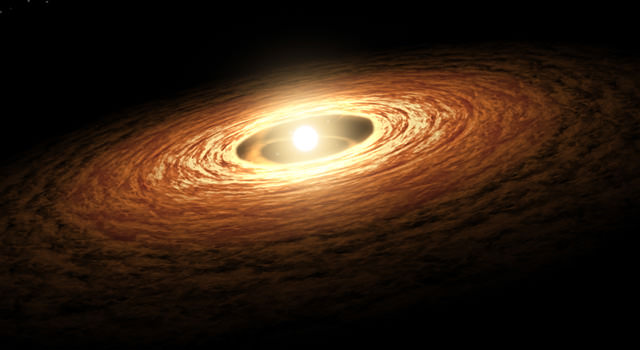[/caption]
Catching a ring – or accretion disk – around a star isn’t unusual. However, catching a sharply defined carbon-dioxide ring around a young, magnetic star that’s precisely 1 AU away with a width 0.32 AU or less might raise a few eyebrows. This isn’t just any disk, either… It’s been likened as a “rope-like structure” and there’s even more to the mystery. It’s encircling a Herbig Ae star.
Discovered with the European Southern Observatory’s Very Large Telescope, the edges of this accretion disk are uniquely crisp. Located in the constellation of Centaurus at about 700 light years distant, V1052 (HD 101412) is a parent star with an infrared excess. “HD 101412 is most unusual in having resolved, magnetically split spectral lines which reveal a surface field modulus that varies between 2.5 to 3.5 kG.” says C.R. Cowley (et al). Previous studies “have surveyed molecular emission in a variety of young stellar objects. They found the emission to be much more subdued in Herbig Ae/Be stars than their cooler congeners, the T Tauri stars. This was true for HD 101412 as well, which was among the 25 Herbig Ae/Be stars they discussed. One exception, however, was the molecule CO2, which had a very large flux in HD 101412; indeed, only one T Tauri star had a higher CO2 flux.”
It’s not unusual for carbon dioxide to be found near young stars, but it is a bit more normal for it to be distributed throughout the disk region. “It’s exciting because this is the most constrained ring we’ve ever seen, and it requires an explanation,” explains Cowley, who is professor emeritus at the University of Michigan and leader of the international research effort. “At present time, we just don’t understand what makes it a rope rather than a dish.”
Because V1052 itself is different could be the reason. It is hypothesized the magnetic fields may be holding the rings in the disk structure at a certain distance. The idea has also been forwarded that there may be “shepherding planets”, much like Saturn’s ring structure, which may be the cause. “What makes this star so special is its very strong magnetic field and the fact that it rotates extremely slow compared to other stars of the same type,” said Swetlana Hubrig, of the Leibniz Institute for Astrophysics Potsdam (AIP), Germany.
One thing that is certain is how clean and well-defined the disk lines are centered around the Earth/Sun distance. This accords well with computer modeling where “A wider disk will not fit the observations.” These observations – and the exotic parent star – have been under intense scrutiny since 2008 and the findings have been recently published on-line in Astronomy and Astrophysics. It’s work that helps deepen the understanding of the interaction between central stars, their magnetic fields, and planet-forming disks. It also allows for fact finding when it comes to diverse systems and better knowledge of how solar systems form… even unusual ones.
“Why do turbulent motions not tear the ring apart?” Cowley wondered. “How permanent is the structure? What forces might act to preserve it for times comparable to the stellar formation time itself?”
When it comes to Herbig Ae stars, they are not only rare, but present a rare opportunity for study. In this case, it gives the team something to be quite excited about.
“This star is a gift of nature,” Hubrig said
Original Story Source: Leibniz Institute for Astrophysic News Release. For Further Reading: The narrow, inner CO ring around the magnetic Herbig Ae star, HD 101412.


[Ivan] Yo, Tammy! It is a carbon monoxide ring they observe, most or all of those carbon dioxide references should likely be replaced. [/Ivan] And I don’t think it is an observation feature of CO lines either, correct me if I am wrong but wouldn’t CO2 be rare or nonexistent inside the ice line?
Tightly shepherding a CO ring sounds like a Neptune or two in the making. According to Wikipedia our own Neptune has ~ 1-2 % CH4. (Terrestrials mostly soak up PAH for carbons from their solid planetesimals.)
So I take it the accompanying image does NOT accurately portray the ring in question? As I read it, it should show a very defined “rope-like” structure possibly guarded by a couple of herding planets. BTW, I found the description of a Herbig Ae star to be about as useful as a brick of gold for a drowning victim.
And what makes everyone think that this is a natural structure?